A BIRTHDAY TRIBUTE: The celebrated Mr. K sweeps through the Silver Age…

By PAUL KUPPERBERG
Here’s the thing. When I started reading comics, neither Marvel nor Stan Lee existed.
I mean, they did, but Marvel was called Atlas or Timely or whatever and were publishing monster comics and Westerns and Millie the Model and Stan Lee was doing whatever Stan Lee did before Fantastic Four #1 (Nov. 1961), but whatever it was he and the comics he wrote/edited were, they were entirely off my radar.
By the time Marvel Comics became Marvel Comics, I was already heavily imprinted by the heroes and worlds of DC Comics. Superman was (and remains) my spirit character, in the group of titles overseen by editor Mort Weisinger (about whom I recently posted). Wonder Woman, from the strange mind of Robert Kanigher, was my comfort character, then filled with fantasy and fairy tale elements perfectly suited for my five-, six-, seven-year-old imagination.
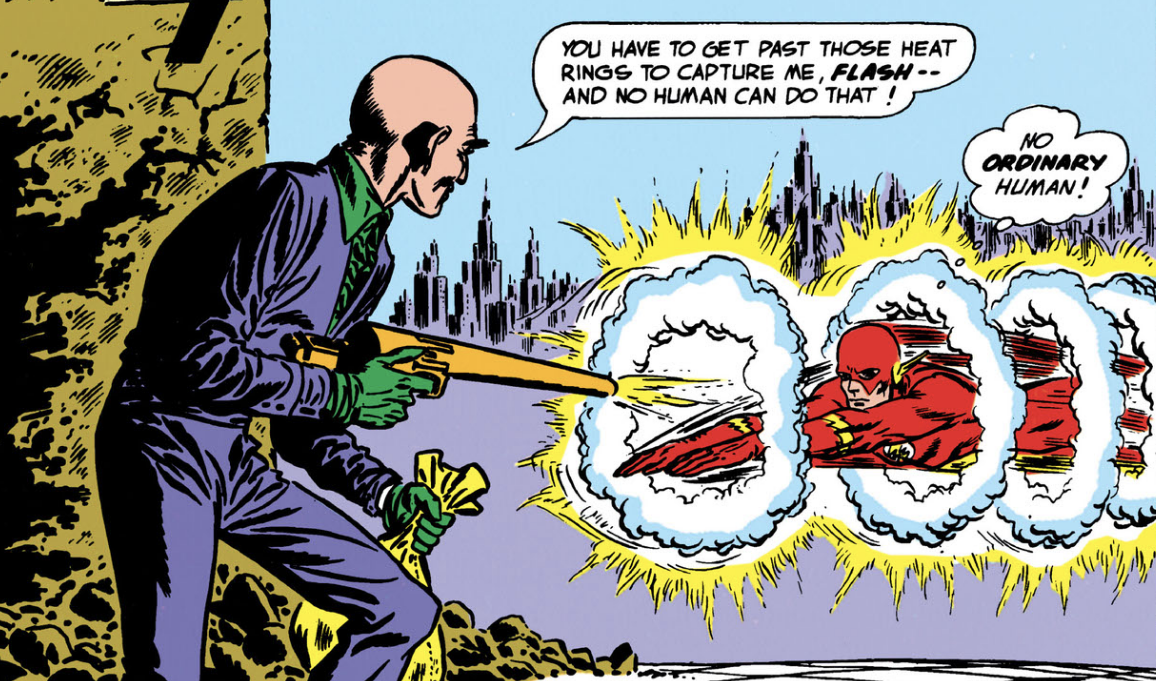
A couple of years later, I expanded what I would read, including Marvel’s output (snuck from my brother’s collection so I didn’t have to “waste” my own limited resources buying them and take away from the DC books I followed). Which led me to the more sophisticated titles like Justice League of America, Green Lantern, The Atom, and The Flash, and the rest of the circle of books edited by Julie Schwartz and written for the most part by Gardner Fox and John Broome (May 4, 1913 – March 14, 1999).
Since Julie’s books ran creator credits, it didn’t take me long to add up that Schwartz plus Broome or Fox equaled awesome. Twenty years later, I would try explainimg to Julie that je ne sais quoi that had drawn me to the stories they had created during my childhood, and he interrupted me and said, “It’s because we weren’t comic book story men, we were quote, unquote story story men.”
Having myself been involved in numerous plotting sessions with Schwartz, I got it right away. He approached every plot like a self-contained short story, not concerned with superheroics and flashy visuals (those would come later), but with characterization, motivations, and, more often than not, the frailties and flaws of his protagonists in their unmasked lives.
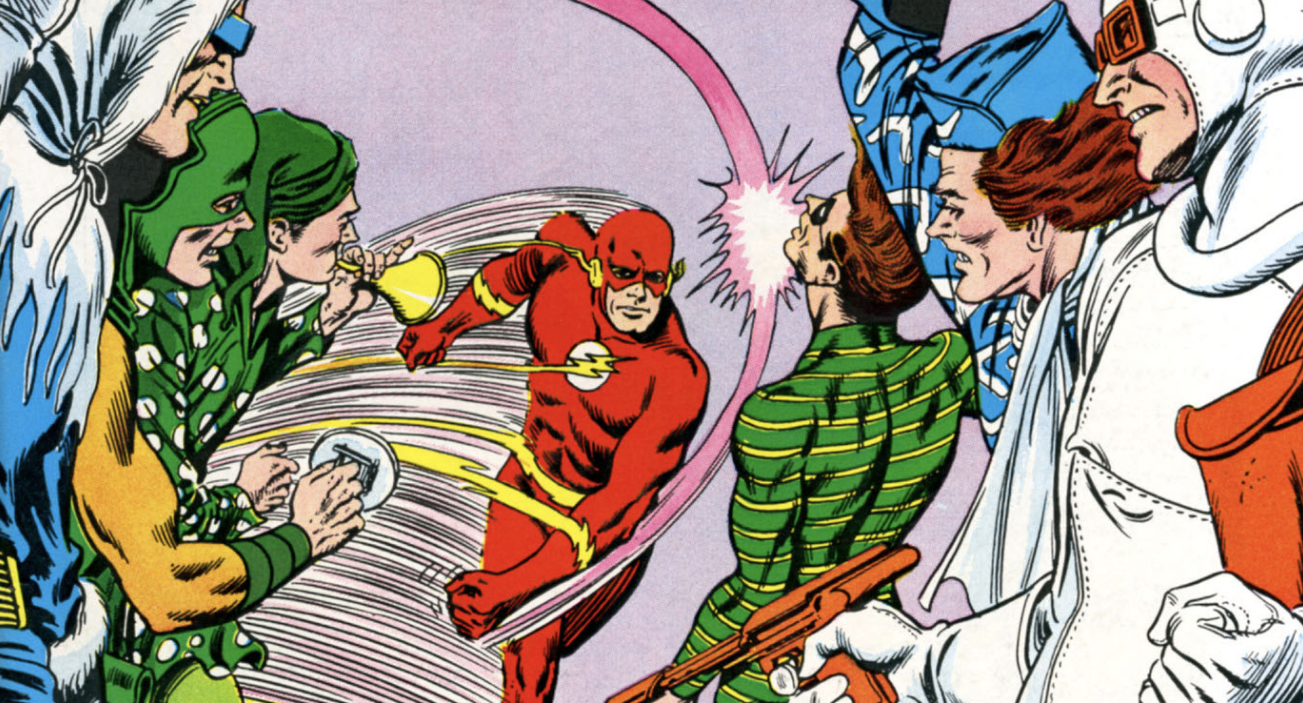
Like Schwartz and Fox, John Broome had come to comic books via the science fiction pulp magazine world of the 1930s. Julie, who had been a literary agent for science fiction writers admitted that the SF community held the new medium of comic books in scorn, although that didn’t stop many of the writers from going to work for the “squinkas,” so-called because you had to kind of “squink” your eyes to read the poorly printed stories.
SF author Broome was a fairly early adaptor, writing for Centaur and Fawcett until, in 1944, his agent, Julie Schwartz, was hired as a story editor at DC Comics, and John found himself invited to write Flash, Green Lantern, Sargon the Sorcerer and Justice Society of America. With Irwin Hasen, he created JSA villain Per Degaton. In the 1950s, he co-created with Carmine Infantino Captain Comet, Detective Chimp and the Phantom Stranger. With Murphy Anderson, he came up with the Atomic Knights.
Robert Kanigher—a writer on the Golden Age feature—may have written the introductory origin story of the Flash in Showcase #4’s “Mystery of the Human Thunderbolt,” but it was John Broome (writer of “The Rival Flash,” the final Flash story in 1949’s Flash Comics #104) who picked up the ball and ran with it (as it were), beginning with the issue’s second story. He continued to write the tales of the Fastest Man Alive, missing only a couple of dozen issues over the next 14 years.
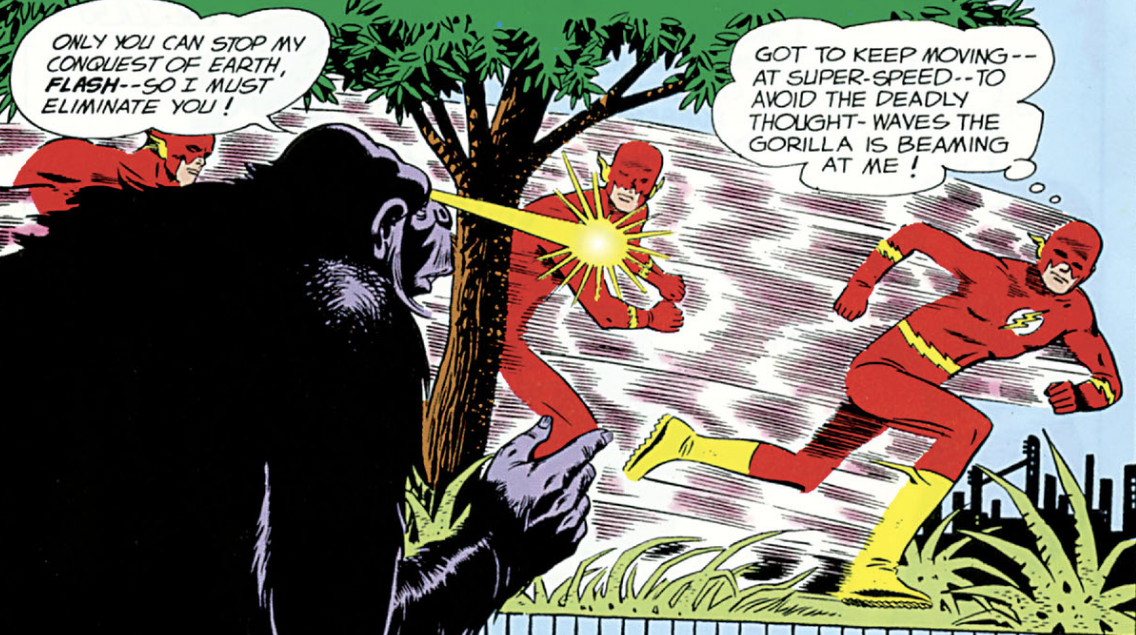
Many date the start of comics’ Silver Age to Showcase #4, myself included, and I also credit The Flash as the spine of the developing DCU throughout the 1960s: from The Flash came not only the idea of reviving the Golden Age heroes in new incarnations (followed by Green Lantern, the Atom, and others), which in turn provided the line-up for the revived JSA, now called the Justice League of America… but also the seeds for what would lead to the revelation of the Multiverse (Flash #123, “The Flash of Two Worlds,” by Fox, Infantino, and Joe Giella), which begat the annual Earth-One/Earth-Two JLA/JSA crossovers, which reintroduced modern readers to countless lost heroes from the Golden Age.
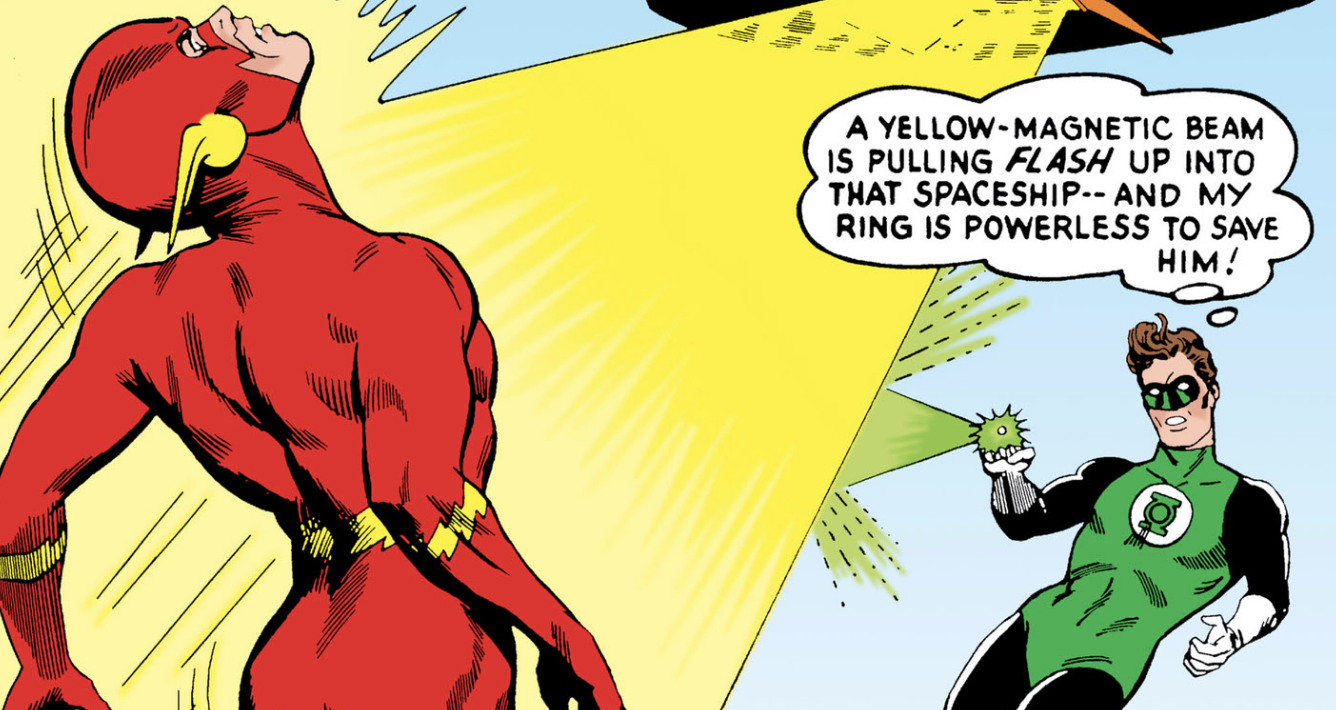
John and his wife lived mostly abroad since the late ’60s, first in Paris and, after John retired from writing comics in 1970, Japan, where John taught English. I met him once, when he was visiting Julie in the DC offices in 1998 during a rare return to the States to attend San Diego Comic-Con the year prior to his death. I told him how important I thought his work on The Flash was to me and to DC Comics writ large.
He chuckled and said, “You mean you weren’t reading Marvel Comics like everybody else back then?”
“I did, but I wasn’t as impressed by Stan Lee then as I was with John Broome,” I said, and I meant it. I still do.
Here then, MY 13 FAVORITE JOHN BROOME FLASH STORIES:
—
Showcase #4 (Sept./Oct. 1956). Picking up seamlessly from Kanigher’s origin story, John Broome penned the second Barry Allen Flash tale, “The Man Who Broke the Time Barrier” (with Infantino and Joe Kubert), wasting no time in introducing traditional science fiction tropes into the superhero tales. All the Schwartz-revived heroes were heavily science-based, from elements of their origins to their spheres of operation.
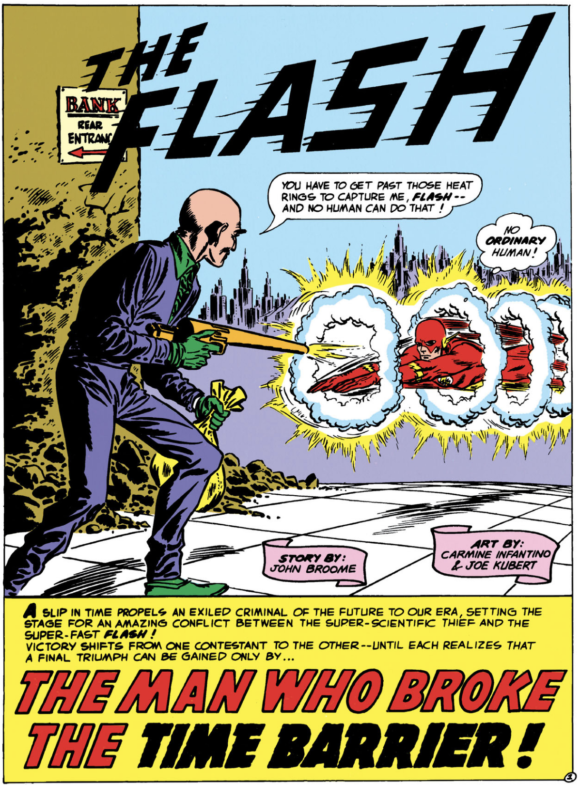
—
The Flash #105 (Feb./March 1959). With the release of the Flash’s eponymous title, John Broome assumed the role as lead writer and celebrated the event with the introduction of Mirror Master, the third member of the Flash’s Rogues Gallery after Captain Cold and Mr. Element (later Dr. Alchemy). The series picked up the numbering from the Golden Age run, which ended in 1949; in 1959, the common wisdom was that #1s didn’t sell because readers didn’t want untested titles but long running ones they could count on being there.
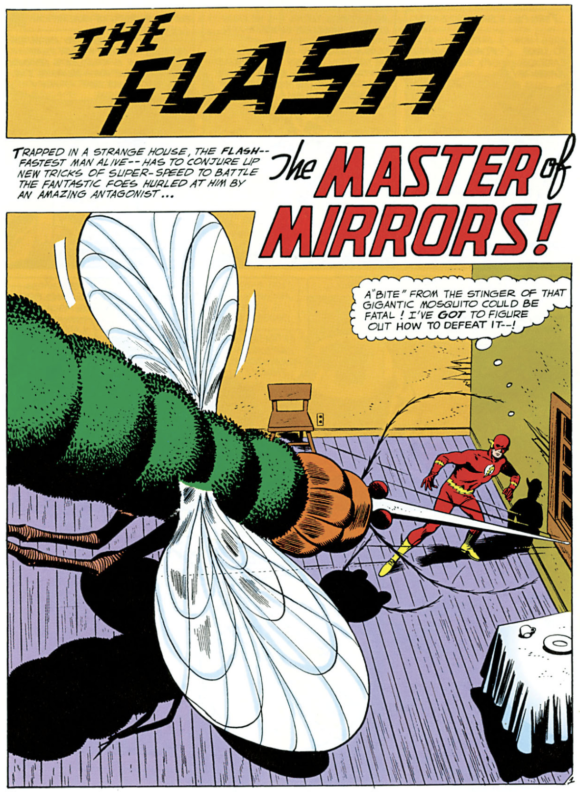
Carmine Infantino pencils, Joe Giella inks
—
The Flash #106 (April/May 1959). I intended to jump ahead a bit in the run, but the issue right after he gave us Mirror Master, Broome delivered a one-two punch issue introducing readers to not only Gorilla Grodd and Gorilla City, but also to the Pied Piper. Talk about being quick off the starting line!
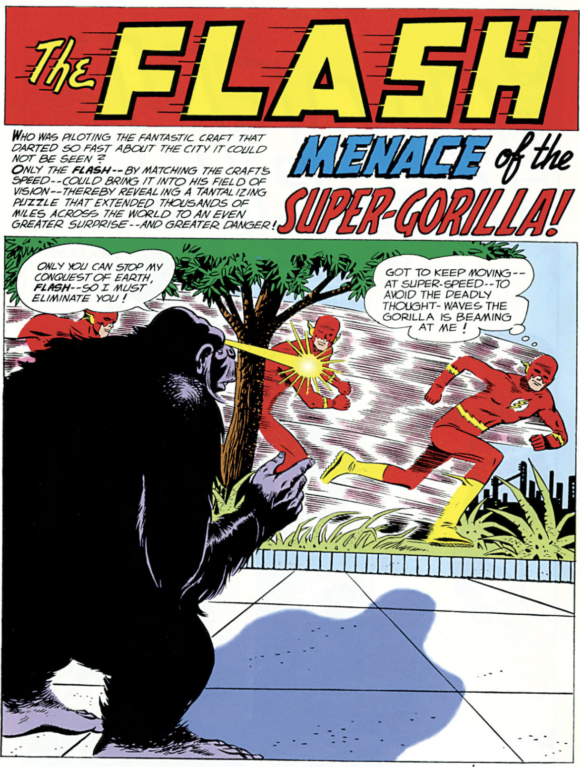
Infantino and Giella
—
The Flash #115 (Sept. 1960). And so it began… the first of many stories featuring the Flash undergoing bizarre metamorphoses, this one with an unforgettable cover near the beginning of what I consider an unbeatable run of covers (a topic I covered in the foreword to DC Comics’ 2012 The Flash Archives Vol. 6), most fueled by Broome’s stories. But even if it were a one-off, “The Day Flash Weighed 1,000 Pounds” is a memorable tale.
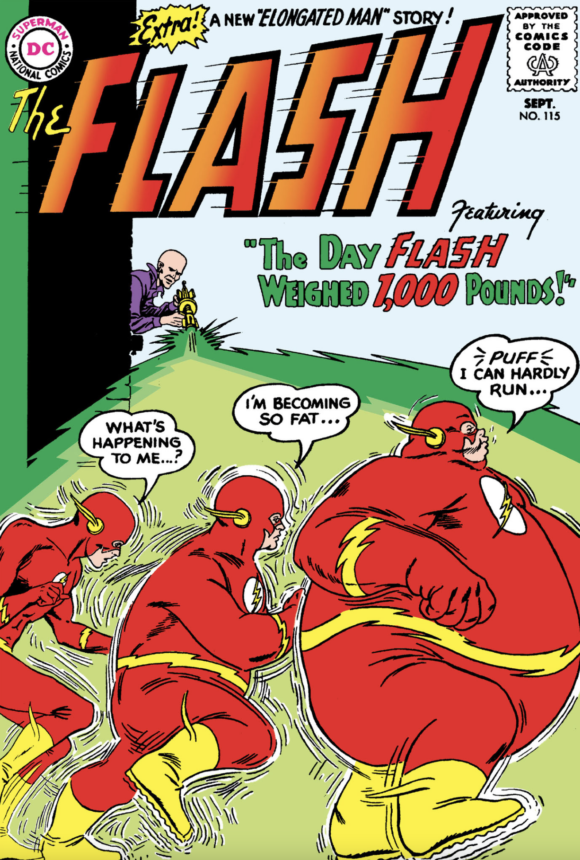
Infantino and Giella
—
The Flash #125 (Dec. 1961). Another time travel story, co-starring Kid Flash, aka Wally West, who had been introduced the previous year with little fanfare in a Broome-scripted story. Time travel tales can be tricky, but Broome always managed to pull it off.
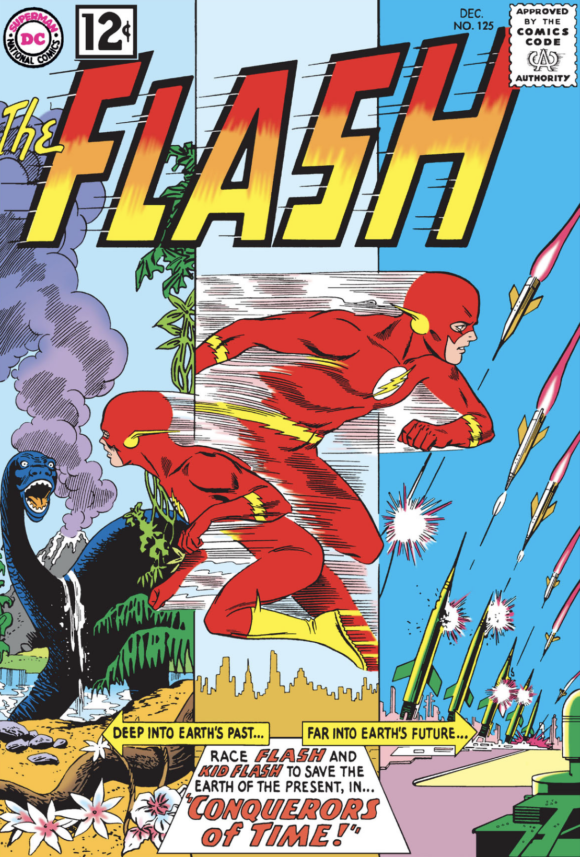
Infantino and Giella
—
The Flash #131 (Sept. 1962). Broome was simultaneously writing Green Lantern, which probably made a team-up with his JLA teammate the Flash inevitable. Such a story happened in Green Lantern #13 (June 1962) which ended with an editorial message that it was “the first of a series of proposed stories featuring Green Lantern and the Flash working as a team!” They asked for readers to let them know if they wanted more; just a few months later Flash and GL were back together as “Captives of the Cosmic Ray!”
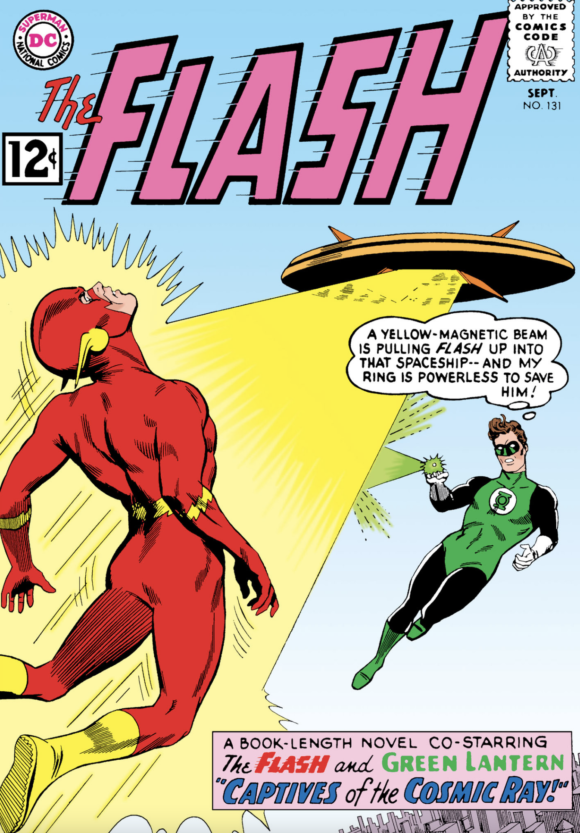
Infantino and Giella
—
The Flash #133 (December 1962). Because it’s fanboy malpractice not to include “Plight of the Puppet-Flash!” on any list. As if anyone would want to!
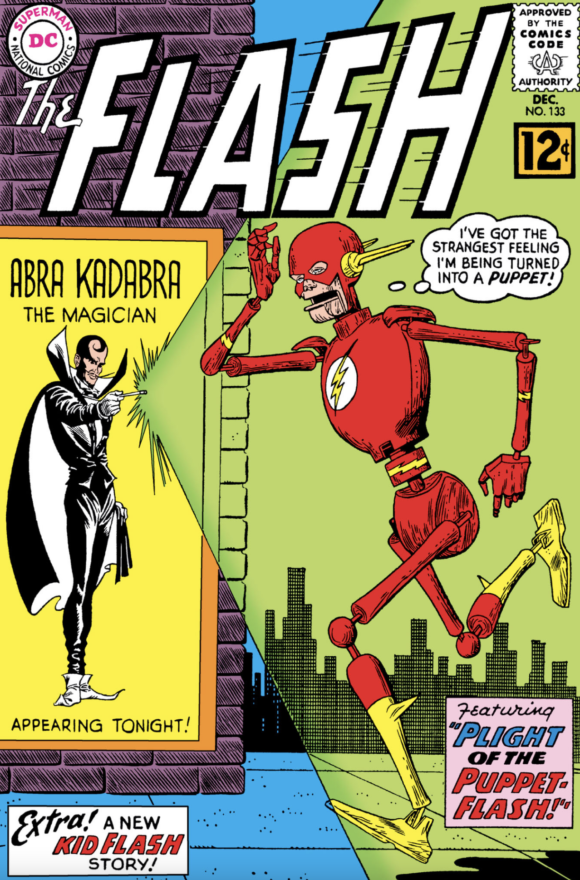
Infantino pencils, Murphy Anderson inks
—
The Flash #139 (September 1963). The 25th century Eobard Thawne, aka Professor Zoom, the Reverse-Flash who would one day have a profound impact on the Flash across many media, got his start here in the Broome-written “Menace of the Reverse Flash!”
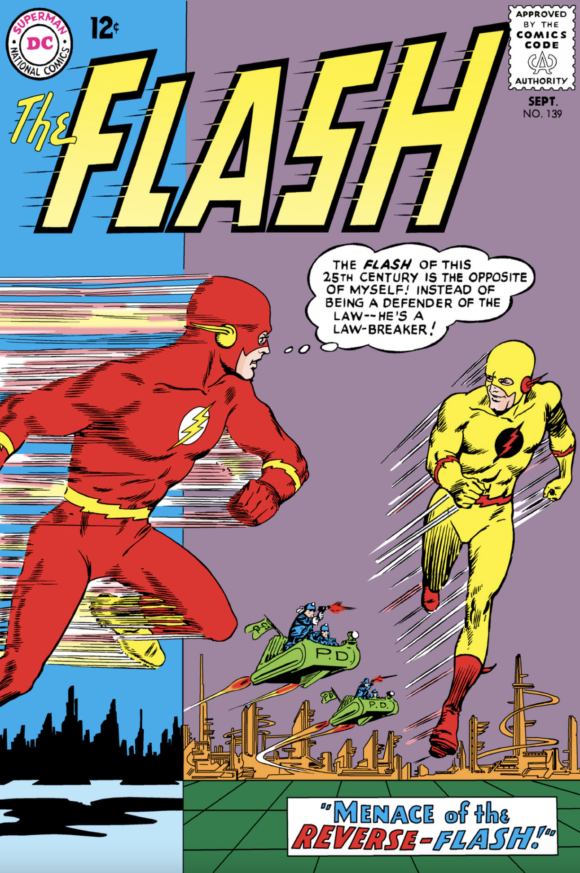
Infantino and Anderson
—
The Flash #147 (September 1964). Topped by a cover shout-out to the landmark cover of The Flash #123, “Our Enemy, the Flash” brings a little Rogues Gallery action as the Reverse-Flash and Mr. Element team up to outwit their common foe.
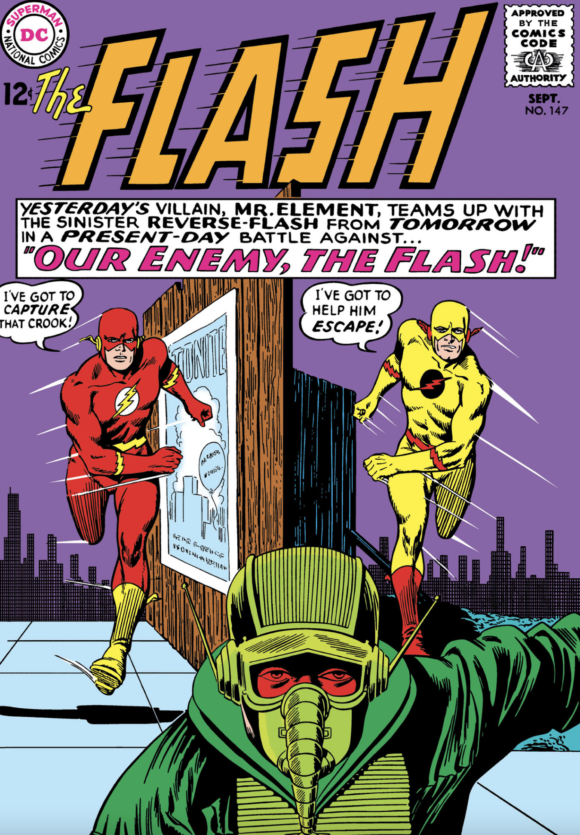
Infantino and Anderson
—
The Flash #155 (September 1965). Did I say a little Rogues Gallery action? Check out “The Gauntlet of Super-Villains!” Six Rogues… under the influence of Gorilla Grodd! John Broome at his best!
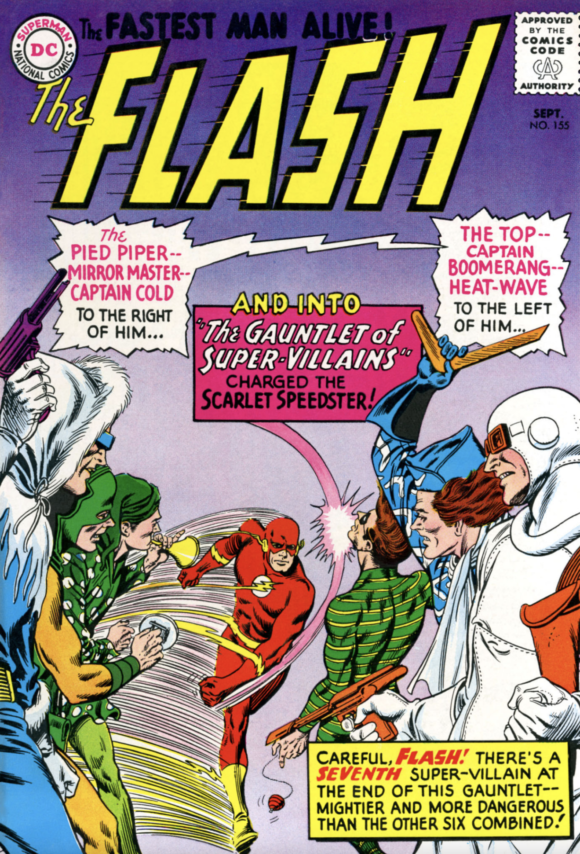
Infantino and Anderson
—
The Flash #163 (August 1966). Which came first, the cover for or the story of, “The Flash Stakes His Life–On–You!”? It wasn’t uncommon back then to come up with a compelling cover image and write a story around it, which I believe was the case with this issue. It is, without doubt, one of the most striking covers of its time, but Broome’s story of a city that’s forgotten their greatest hero easily stands on its own.
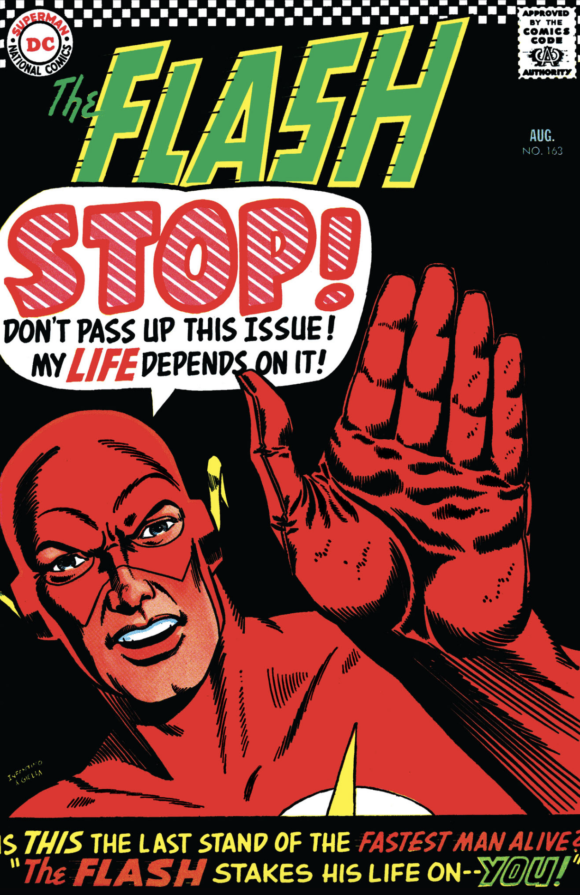
Infantino and Giella
—
The Flash #174 (November 1967). Another Rogues-a-palooza, Broome’s “Stupendous Triumph of the Six Super-Villains” was also notable as the last issue penciled by Infantino until his return 10 years later.
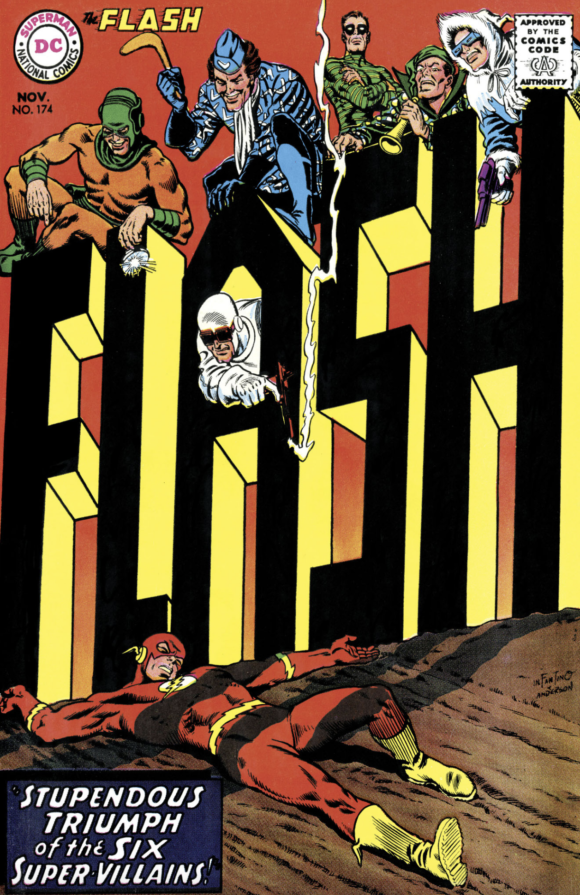
Infantino and Anderson
—
The Flash #190 (August 1969). How could no one have ever thought of this story before?! Spoiler: He gets better, but it still a swell story with moments of Barry facing his genuine fears about never being able to walk, much less run, again.
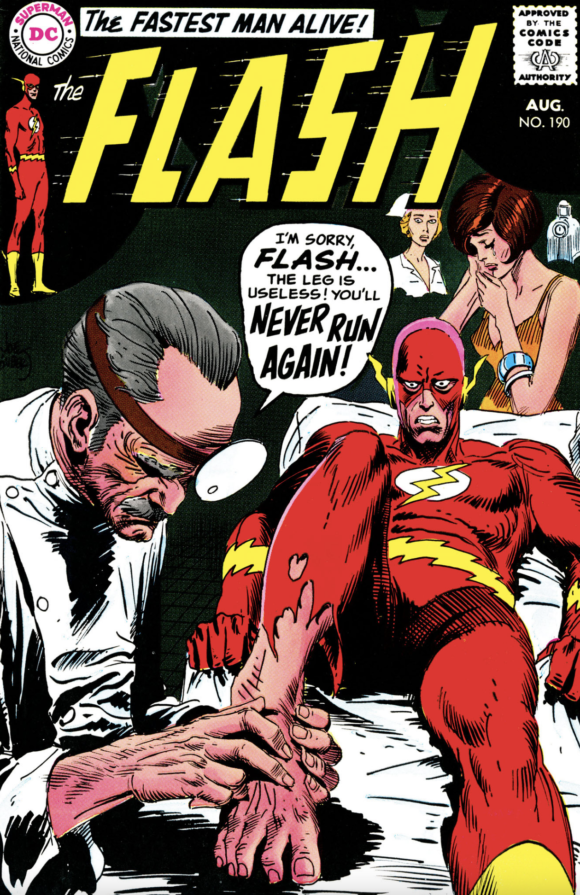
Joe Kubert
—
MORE
— PAUL KUPPERBERG: My 13 Favorite GIL KANE COVERS AND STORIES. Click here.
— PAUL KUPPERBERG: My 13 Favorite DICK DILLIN JLA-JSA Crossover Stories. Click here.
—
Sure, you know Paul Kupperberg as the prolific writer of over a thousand comic books for such characters and series as Superman, Aquaman, Doom Patrol, Vigilante, Life with Archie, Bart Simpson, Scooby-Doo, and dozens more for DC Comics, Archie Comics, Bongo Comics, and others, and that he is also the creator of the series Arion, Lord of Atlantis, Checkmate and Takion, and is a former editor for DC, Weekly World News, and WWE Kids Magazine. But Paul is also the author of numerous books, including the superhero novel JSA: Ragnarok and the comics industry-based murder mystery, The Same Old Story, not to mention (but we will anyway) Paul Kupperberg’s Illustrated Guide to Writing Comics, I Never Write for the Money, But I Always Turn in the Manuscript for a Check, Direct Comments: Comic Book Creators in their Own Words, The Unpublished Comic Book Scripts of Paul Kupperberg and Son of the Unpublished Comic Book Scripts of Paul Kupperberg. You can follow Paul at PaulKupperberg.com and at Crazy8Press.com.
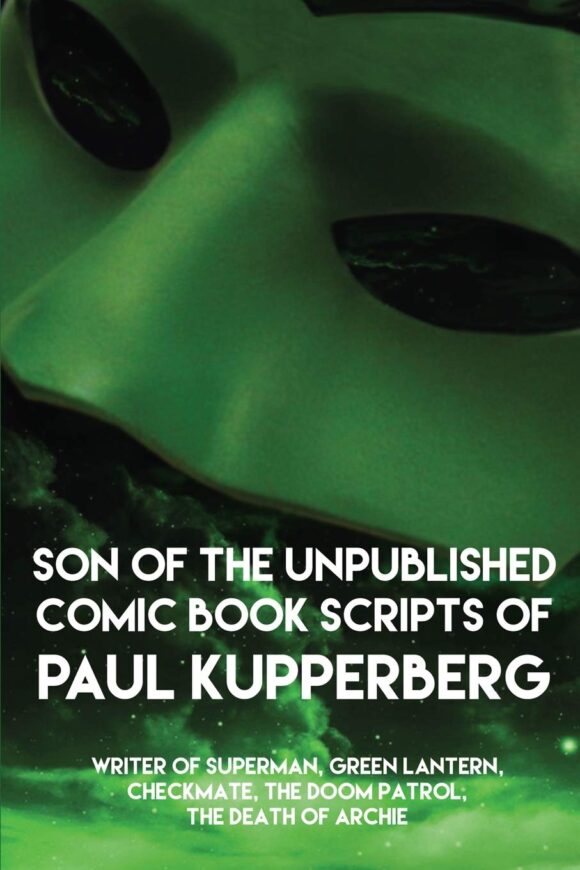

May 4, 2022
Such Super Silver Age Goodness!
May 4, 2022
Flash was always my favorite hero–I would have included the story where the Flash was turned into a sidewalk (I don’t remember the issue number, unfortunately). I most remember the scene where the sidewalk is moving along, and a woman faints when she sees it rolling along.
May 6, 2022
Flash was my favorite back in the late 50s/early 60s. Its pseudo-science elevated it far past the rest of the National/DC fare. The particular story where Gorilla Grodd takes a pill, committing suicide(!) to be reincarnated particularly astounded this young reader.
May 6, 2022
My favorite period for Flash comics. Thank you!